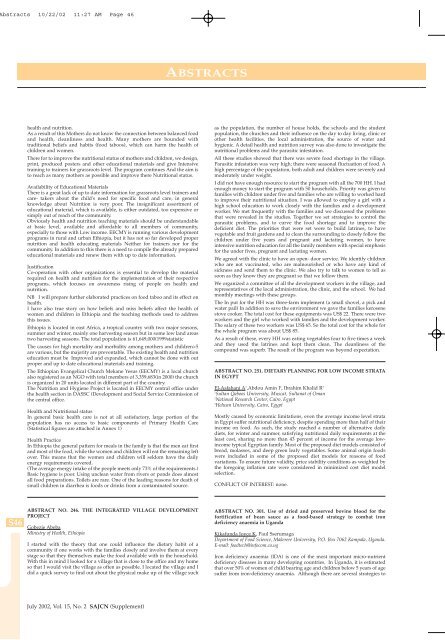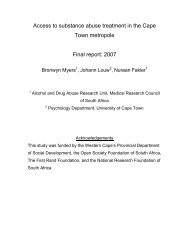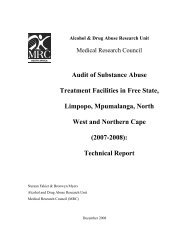Pan-African Conference 21 - 24 July 2002 Inter-Continental Hotel ...
Pan-African Conference 21 - 24 July 2002 Inter-Continental Hotel ...
Pan-African Conference 21 - 24 July 2002 Inter-Continental Hotel ...
You also want an ePaper? Increase the reach of your titles
YUMPU automatically turns print PDFs into web optimized ePapers that Google loves.
Abstracts 10/22/02 11:27 AM Page 46<br />
S46<br />
health and nutrition.<br />
As a result of this Mothers do not know the connection between balanced food<br />
and health, cleanliness and health. Many mothers are bounded with<br />
traditional beliefs and habits (food taboos), which can harm the health of<br />
children and women.<br />
There for to improve the nutritional status of mothers and children, we design,<br />
print, produced posters and other educational materials and give Intensive<br />
training to trainers for grassroots level. The program continues And the aim is<br />
to reach as many mothers as possible and improve there Nutritional status.<br />
Availability of Educational Materials<br />
There is a great lack of up to date information for grassroots level trainers and<br />
care- takers about the child's need for specific food and care, in general<br />
knowledge about Nutrition is very poor. The insignificant assortment of<br />
educational material, which is available, is either outdated, too expensive or<br />
simply out of reach of the community.<br />
Obviously health and nutrition teaching materials should be understandable<br />
at basic level, available and affordable to all members of community,<br />
especially to those with Low income. EECMY is running various development<br />
programs in rural and urban Ethiopia, but it has not so far developed proper<br />
nutrition and health educating materials Neither for trainers nor for the<br />
community. In addition to this there is a need to compile the already prepared<br />
educational materials and renew them with up to date information.<br />
Justification<br />
Co-operation with other organizations is essential to develop the material<br />
required on health and nutrition for the implementation of their respective<br />
programs, which focuses on awareness rising of people on health and<br />
nutrition.<br />
NB I will prepare further elaborated practices on food taboo and its effect on<br />
health.<br />
I have also true story on how beliefs and miss beliefs affect the health of<br />
women and children in Ethiopia and the teaching methods used to address<br />
this issues.<br />
Ethiopia is located in east Africa, a tropical country with two major seasons,<br />
summer and winter, mainly one harvesting season but in some low land areas<br />
two harvesting seasons. The total population is 61,649,000(1999statistic<br />
The causes for high mortality and morbidity among mothers and children>5<br />
are various, but the majority are preventable. The existing health and nutrition<br />
education must be Improved and expanded, which cannot be done with out<br />
proper and up to date educational materials and training.<br />
The Ethiopian Evangelical Church Mekane Yesus (EECMY) is a local church<br />
also registered as an NGO with total members of 3,359,683(in 2000) the church<br />
is organized in 20 units located in different part of the country.<br />
The Nutrition and Hygiene Project is located in EECMY central office under<br />
the health section in DASSC (Development and Social Service Commission of<br />
the central office.<br />
Health and Nutritional status<br />
In general basic health care is not at all satisfactory, large portion of the<br />
population has no access to basic components of Primary Health Care<br />
(Statistical figures are attached in Annex 1)<br />
Health Practice<br />
In Ethiopia the general pattern for meals in the family is that the men eat first<br />
and most of the food, while the women and children will eat the remaining left<br />
over. This means that the women and children will seldom have the daily<br />
energy requirements covered.<br />
(The average energy intake of the people meets only 73% of the requirements.)<br />
Basic hygiene is poor. Using unclean water from rivers or ponds does almost<br />
all food preparations. Toilets are rare. One of the leading reasons for death of<br />
small children in diarrhea is foods or drinks from a contaminated source.<br />
ABSTRACT NO. <strong>24</strong>6. THE INTEGRATED VILLAGE DEVELOPMENT<br />
PROJECT<br />
Gobezie Abeba<br />
Ministry of Health, Ethiopia<br />
I started with the theory that one could influence the dietary habit of a<br />
community if one works with the families closely and involve them at every<br />
stage so that they themselves make the food available with in the household.<br />
With this in mind I looked for a village that is close to the office and my home<br />
so that I would visit the village as often as possible. I located the village and I<br />
did a quick survey to find out about the physical make up of the village such<br />
<strong>July</strong> <strong>2002</strong>, Vol. 15, No. 2 SAJCN (Supplement)<br />
ABSTRACTS<br />
as the population, the number of house holds, the schools and the student<br />
population, the churches and their influence on the day to day living, clinic or<br />
other health facilities, the local administration, the source of water and<br />
hygienic. A detail health and nutrition survey was also done to investigate the<br />
nutritional problems and the parasitic infestation.<br />
All these studies showed that there was severe food shortage in the village.<br />
Parasitic infestation was very high; there were seasonal fluctuation of food. A<br />
high percentage of the population, both adult and children were severely and<br />
moderately under weight.<br />
I did not have enough resource to start the program with all the 700 HH. I had<br />
enough money to start the program with 50 households. Priority was given to<br />
families with children under five and families who are willing to worked hard<br />
to improve their nutritional situation. I was allowed to employ a girl with a<br />
high school education to work closely with the families and a development<br />
worker. We met frequently with the families and we discussed the problems<br />
that were revealed in the studies. Together we set strategies to control the<br />
parasitic problems, and to curve the food shortage and to improve the<br />
deficient diet. The priorities that were set were to build latrines, to have<br />
vegetable and fruit gardens and to clean the surrounding to closely follow the<br />
children under five years and pregnant and lactating women, to have<br />
intensive nutrition education for all the family members with special emphasis<br />
for the under fives, pregnant and lactating women.<br />
We agreed with the clinic to have an open- door service. We identify children<br />
who are not vaccinated, who are malnourished or who have any kind of<br />
sickness and send them to the clinic. We also try to talk to women to tell as<br />
soon as they know they are pregnant so that we follow them.<br />
We organized a committee of all the development workers in the village, and<br />
representatives of the local administration, the clinic, and the school. We had<br />
monthly meetings with these groups.<br />
The In put for the HH was three-farm implement (a small shovel, a pick and<br />
water pail) In addition to save the environment we gave the families kerosene<br />
stove cooker. The total cost for these equipments was US$ 22. There were two<br />
workers and the girl who worked with families and the development worker.<br />
The salary of these two workers was US$ 65. So the total cost for the whole for<br />
the whole program was about US$ 85.<br />
As a result of these, every HH was eating vegetables four to five times a week<br />
and they used the latrines and kept them clean. The cleanliness of the<br />
compound was superb. The result of the program was beyond expectation.<br />
ABSTRACT NO. 251. DIETARY PLANNING FOR LOW INCOME STRATA<br />
IN EGYPT<br />
El-Asfahani A 1 ,Abdou Amin I 2 , Ibrahim Khalid R 3<br />
1 Sultan Qaboos University, Muscat, Sultanat of Oman<br />
2 National Research Center, Cairo, Egypt<br />
3 Helwan University, Cairo, Egypt<br />
Mostly caused by economic limitations, even the average income level strata<br />
in Egypt suffer nutritional deficiency, despite spending more than half of their<br />
income on food. As such, the study reached a number of alternative daily<br />
diets, for winter and summer, satisfying nutritional daily requirements at the<br />
least cost, sharing no more than 43 percent of income for the average lowincome<br />
typical Egyptian family. Most of the proposed diet models consisted of<br />
bread, molasses, and deep green leafy vegetables. Some animal origin foods<br />
were included in some of the proposed diet models for reasons of food<br />
variations. To ensure future validity, price stability conditions as weighted by<br />
the foregoing inflation rate were considered in minimized cost diet model<br />
selection.<br />
CONFLICT OF INTEREST: none.<br />
ABSTRACT NO. 301. Use of dried and preserved bovine blood for the<br />
fortification of bean sauce as a food-based strategy to combat iron<br />
deficiency anaemia in Uganda<br />
Kikafunda Joyce K, Paul Sserumaga<br />
Department of Food Science, Makerere University, P.O. Box 7062 Kampala, Uganda.<br />
E-mail: foodtech@infocom.co.ug<br />
Iron deficiency anaemia (IDA) is one of the most important micro-nutrient<br />
deficiency diseases in many developing countries. In Uganda, it is estimated<br />
that over 50% of women of child bearing age and children below 5 years of age<br />
suffer from iron-deficiency anaemia. Although there are several strategies to

















